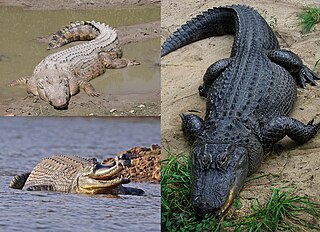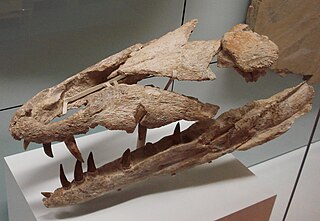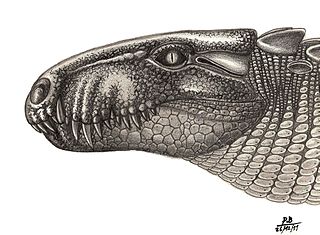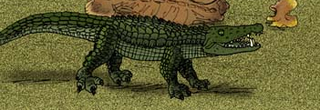External links
- A teleosaurid (Crocodylia, Mesosuchia) from the Toarcian of Madagascar and its palaeobiogeographical significance
- Blue Nile Gorge
- Crocodyliformes
"Mesosuchia" is an obsolete name for a group of terrestrial, semi-aquatic, or fully aquatic crocodylomorph reptiles. The marine crocodile Metriorhynchus had paddle-like forelimbs, Dakosaurus andiniensis had a skull that was adapted to eat large sea reptiles, and Shamosuchus was adapted for eating molluscs and gastropods. Shamosuchus also looked like modern crocodiles and was very closely related to their direct ancestor.
The "Mesosuchia" were formerly placed at Suborder rank as within Crocodylia. The "first" crocodiles were placed within their own suborder, Protosuchia; whilst extant species where placed within Suborder Eusuchia (meaning 'true crocodiles'). Mesosuchia were the crocodylians "in between".But it is no longer regarded as genuine because it belongs to a paraphyletic group. It is replaced by its phylogenetic equivalent Mesoeucrocodylia, which contains the taxa herein, the Crocodylia, and some allied forms more recently discovered.
The "Mesosuchia" was composed as:

Crocodilia is an order of mostly large, predatory, semiaquatic reptiles, known as crocodilians. They first appeared 95 million years ago in the Late Cretaceous period and are the closest living relatives of birds, as the two groups are the only known survivors of the Archosauria. Members of the order's total group, the clade Pseudosuchia, appeared about 250 million years ago in the Early Triassic period, and diversified during the Mesozoic era. The order Crocodilia includes the true crocodiles, the alligators and caimans, and the gharial and false gharial. Although the term 'crocodiles' is sometimes used to refer to all of these, crocodilians is a less ambiguous vernacular term for members of this group.
Several groups of tetrapods have undergone secondary aquatic adaptation, an evolutionary transition from being purely terrestrial to living at least part of the time in water. These animals are called "secondarily aquatic" because although their ancestors lived on land for hundreds of millions of years, they all originally descended from aquatic animals. These ancestral tetrapods had never left the water, and were thus primarily aquatic, like modern fishes. Secondary aquatic adaptations tend to develop in early speciation as the animal ventures into water in order to find available food. As successive generations spend more time in the water, natural selection causes the acquisition of more adaptations. Animals of later generations may spend the majority of their life in the water, coming ashore for mating. Finally, fully adapted animals may take to mating and birthing in water or ice.

Marine reptiles are reptiles which have become secondarily adapted for an aquatic or semiaquatic life in a marine environment.

Caniformia is a suborder within the order Carnivora consisting of "dog-like" carnivorans. They include dogs, bears, raccoons, and mustelids. The Pinnipedia are also assigned to this group. The center of diversification for the Caniformia is North America and northern Eurasia. Caniformia stands in contrast to the other suborder of Carnivora, the Feliformia, the center of diversification of which was in Africa and southern Asia.

Baru is an extinct genus of Australian mekosuchine crocodilian. It was semi-aquatic, around 4 m (13 ft) in length. Being semi-aquatic its habitat was around fresh pools of water in wet forests, ambushing their prey, much like modern species. The word Baru is Aboriginal and means "crocodile's ancestor".

Dakosaurus is an extinct genus of crocodylomorph within the family Metriorhynchidae that lived during the Late Jurassic and Early Cretaceous. It was large, with teeth that were serrated and compressed lateromedially. The genus was established by Friedrich August von Quenstedt in 1856 for an isolated tooth named Geosaurus maximus by Theodor Plieninger in 1846. Dakosaurus was a carnivore that spent much, if not all, its life out at sea. The extent of its adaptation to a marine lifestyle means that it is most likely that it mated at sea, but since no eggs or nests have been discovered that have been referred to Dakosaurus, whether it gave birth to live young at sea like dolphins and ichthyosaurs or came ashore like turtles is not known. The name Dakosaurus means "biter lizard", and is derived from the Greek dakos ("biter") and σαῦρος -sauros ("lizard").

Machimosaurus is an extinct genus of machimosaurid crocodyliform from the Late Jurassic and Early Cretaceous. The type species, Machimosaurus hugii, was found in Switzerland. Other fossils have been found in England, France, Germany, Portugal, Switzerland and Tunisia. Machimosaurus rex is the largest named teleosauroid and thalattosuchian, with an estimated length of up to 7.15 m (23.5 ft). Machimosaurus is the largest known crocodyliform of the Jurassic.

Pseudosuchia is one of two major divisions of Archosauria, including living crocodilians and all archosaurs more closely related to crocodilians than to birds. Pseudosuchians are also informally known as "crocodilian-line archosaurs". Prior to 2011, the clade Pseudosuchia was often called Crurotarsi in reference to the crurotarsal ankle found in almost all members of the group, which traditionally included phytosaurs, ornithosuchids, and suchians. However, a major 2011 study of Triassic archosaur relations proposed that phytosaurs were not closely related to other traditional "crurotarsans", at least compared to "bird-line archosaurs" (Avemetatarsalians) such as pterosaurs and dinosaurs. As a result, the possession of a crurotarsal ankle was considered a plesiomorphic ("primitive") feature retained by pseudosuchians. Crurotarsi now refers to a broader group of reptiles including Pseudosuchia, Phytosauria, and Avemetatarsalia. Despite Pseudosuchia meaning "false crocodiles", the name is a misnomer as true crocodilians are a subset of the group.

Shamosuchus is an extinct genus of neosuchian crocodyliform that lived during the Late Cretaceous (Campanian) period in what is now the Djadokhta Formation of Mongolia, approximately 75 million to 71 million years ago.

Metriorhynchidae is an extinct family of specialized, aquatic metriorhynchoid crocodyliforms from the Middle Jurassic to the Early Cretaceous period of Europe, North America and South America. The name Metriorhynchidae was coined by the Austrian zoologist Leopold Fitzinger in 1843. The group contains two subfamilies, the Metriorhynchinae and the Geosaurinae. They represent the most marine adapted of all archosaurs.

Geosaurus is an extinct genus of marine crocodyliform within the family Metriorhynchidae, that lived during the Late Jurassic and the Early Cretaceous. Geosaurus was a carnivore that spent much, if not all, its life out at sea. No Geosaurus eggs or nests have been discovered, so little is known of the reptile's lifecycle, unlike other large marine reptiles of the Mesozoic, such as plesiosaurs or ichthyosaurs which are known to give birth to live young out at sea. Where Geosaurus mated, whether on land or at sea, is currently unknown. The name Geosaurus means "Mother of Giants lizard", and is derived from the Greek Ge- and σαῦρος -sauros ("lizard"). The name Geosaurus was established by the French naturalist Georges Cuvier in 1824.

Thalattosuchia is a clade of marine crocodylomorphs from the Early Jurassic to the Early Cretaceous that had a cosmopolitan distribution. They are colloquially referred to as marine crocodiles or sea crocodiles, though they are not members of Crocodilia and records from Thailand and China suggest that some members lived in freshwater. The clade contains two major subgroupings, the Teleosauroidea and Metriorhynchoidea. Teleosauroids are not greatly specialised for oceanic life, with back osteoderms similar to other crocodyliformes. Within Metriorhynchoidea, the Metriorhynchidae displayed extreme adaptions for life in the open ocean, including the transformation of limbs into flippers, the development of a tail fluke, and smooth, scaleless skin.

Crocodylomorpha is a group of pseudosuchian archosaurs that includes the crocodilians and their extinct relatives. They were the only members of Pseudosuchia to survive the end-Triassic extinction.

Pelagosaurus is an extinct genus of thalattosuchian crocodyliform that lived during the Toarcian stage of the Lower Jurassic, around 183 Ma to 176 Ma, in shallow epicontinental seas that covered much of what is now Western Europe. The systematic taxonomy of Pelagosaurus has been fiercely disputed over the years, and was assigned to Thalattosuchia after its systematics within Teleosauridae were disputed. Pelagosaurus measured 2–3 m (6.6–9.8 ft) long and weighed 60 kg (130 lb).
Cricosaurus is an extinct genus of marine crocodyliforms of the Late Jurassic. belonging to the family Metriorhynchidae. The genus was established by Johann Andreas Wagner in 1858 for three skulls from the Tithonian of Germany. The name Cricosaurus means "Ring lizard", and is derived from the Greek Krikos- ("ring") and σαῦρος -sauros ("lizard"). It was a relatively small reptile, with C. suevicus and C. araucanensis measuring 2 m (6.6 ft) and 3.2 m (10 ft) in total body length, respectively.

Bretesuchus is an extinct genus of sebecosuchian mesoeucrocodylian within the family Sebecidae known from northwestern Argentina. It was a large apex predator.

Sebecus is an extinct genus of sebecid crocodylomorph from Eocene of South America. Like other sebecosuchians, it was entirely terrestrial and carnivorous. The genus is currently represented by two species, the type S. icaeorhinus and S. ayrampu. Several other species have been referred to Sebecus, but were later reclassified as their own genera.

Planocrania is an extinct genus of eusuchian crocodyliforms from what is now China. Two species are currently known to belong to the genus.
Shantungosuchus is an extinct genus of Early Cretaceous crocodyliform found in China. It includes three species: Shantungosuchus chuhsienensis and S. brachycephalus, which were both described by Yang Zhongjian – usually referred to as "Young" – in 1961 and 1982, and S. hangjinensis, which was described by Xiao-Chun Wu et al in 1994. S. chuhsienensis is the type for this genus.

Thalattosuchus is an extinct genus of marine crocodyliform that lived in the oceans during the Middle to Late Jurassic. Thalattosuchus was named in 2020. Thalattosuchus was a carnivore that spent much, if not all, its life out at sea. No Thalattosuchus eggs or nests have been discovered, so little is known of the reptile's life cycle, unlike other large marine reptiles of the Mesozoic, such as plesiosaurs or ichthyosaurs which are known to have given birth to live young out at sea. Where Thalattosuchus mated, whether on land or at sea, is currently unknown. The name Thalattosuchus means "sea crocodile".